change wheel Seat Altea 2005 User Guide
[x] Cancel search | Manufacturer: SEAT, Model Year: 2005, Model line: Altea, Model: Seat Altea 2005Pages: 286, PDF Size: 9.59 MB
Page 227 of 286
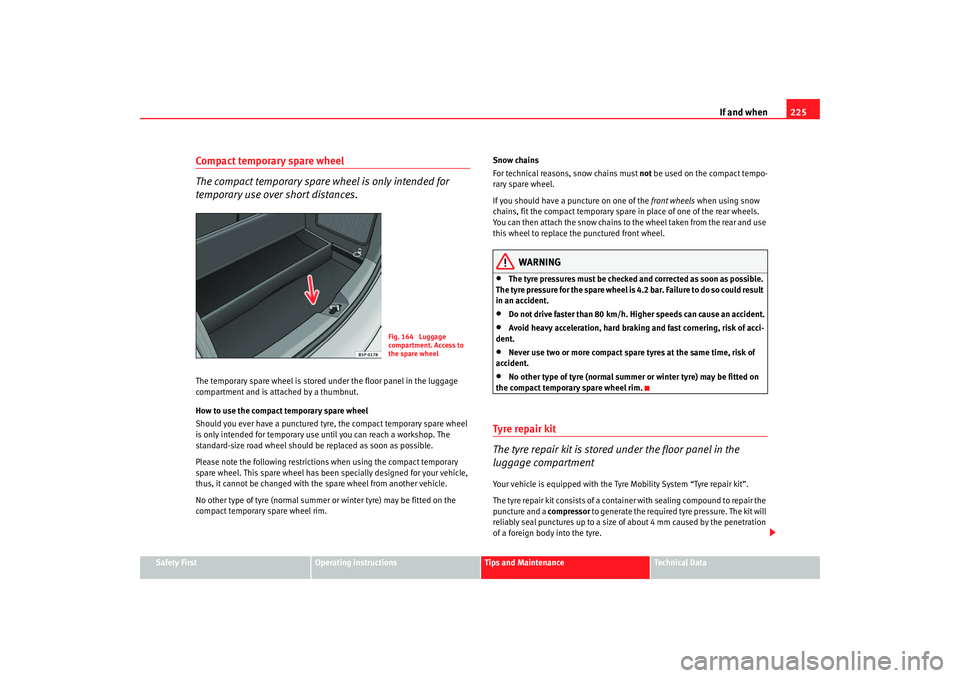
If and when225
Safety First
Operating instructions
Tips and Maintenance
Te c h n i c a l D a t a
Compact temporary spare wheel
The compact temporary spare wh eel is only intended for
temporary use over short distances.The temporary spare wheel is stored under the floor panel in the luggage
compartment and is attached by a thumbnut.
How to use the compact temporary spare wheel
Should you ever have a punctured tyre, the compact temporary spare wheel
is only intended for temporary use until you can reach a workshop. The
standard-size road wheel should be replaced as soon as possible.
Please note the following restrictions when using the compact temporary
spare wheel. This spare wheel has been specially designed for your vehicle,
thus, it cannot be changed with th e spare wheel from another vehicle.
No other type of tyre (normal summer or winter tyre) may be fitted on the
compact temporary spare wheel rim. Snow chains
For technical reasons, snow chains must not
be used on the compact tempo-
rary spare wheel.
If you should have a puncture on one of the front wheels when using snow
chains, fit the compact temporary spare in place of one of the rear wheels.
You can then attach the snow chains to the wheel taken from the rear and use
this wheel to replace the punctured front wheel.
WARNING
•
The tyre pressures must be checked and corrected as soon as possible.
The tyre pressure for the spare wheel is 4.2 bar. Failure to do so could result
in an accident.
•
Do not drive faster than 80 km/h. High er speeds can cause an accident.
•
Avoid heavy acceleration, hard braking and fast cornering, risk of acci-
dent.
•
Never use two or more compact spare tyres at the same time, risk of
accident.
•
No other type of tyre (normal summer or winter tyre) may be fitted on
the compact temporary spare wheel rim.
Tyre repair kit
The tyre repair kit is stored under the floor panel in the
luggage compartmentYour vehicle is equipped with the Tyre Mobility System “Tyre repair kit”.
The tyre repair kit consists of a contai ner with sealing compound to repair the
puncture and a compressor to generate the required tyre pressure. The kit will
reliably seal punctures up to a size of about 4 mm caused by the penetration
of a foreign body into the tyre.
Fig. 164 Luggage
compartment. Access to
the spare wheel
altea_ingles Seite 225 Donnerstag, 19. Mai 2005 3:02 15
Page 228 of 286
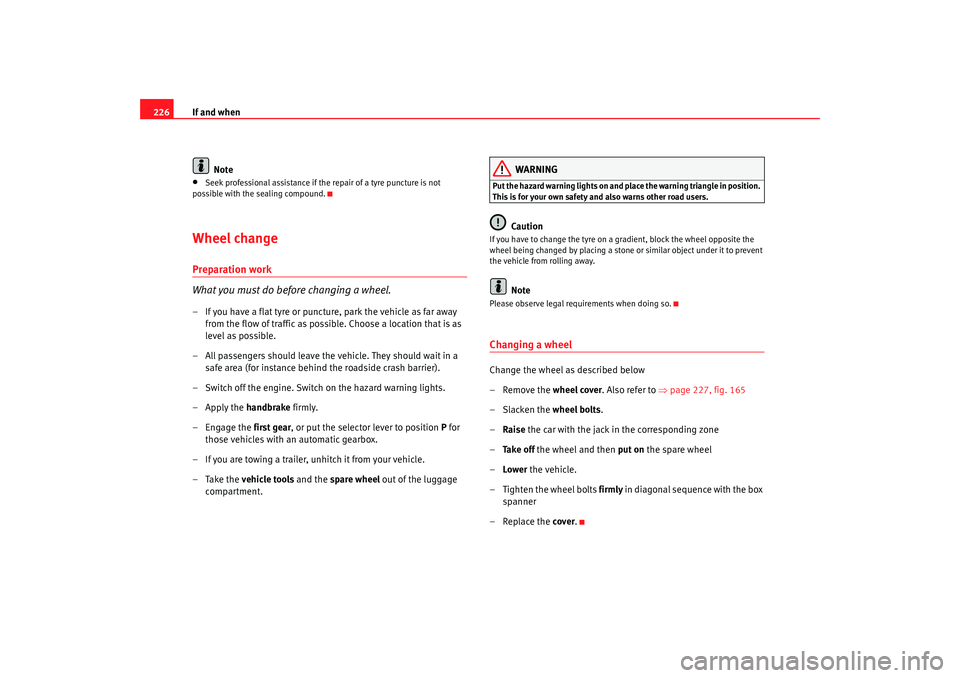
If and when
226
Note•
Seek professional assistance if the repair of a tyre puncture is not
possible with the sealing compound.
Wheel changePreparation work
What you must do before changing a wheel.– If you have a flat tyre or puncture, park the vehicle as far away from the flow of traffic as possible. Choose a location that is as
level as possible.
– All passengers should leave the ve hicle. They should wait in a
safe area (for instance behind the roadside crash barrier).
– Switch off the engine. Switch on the hazard warning lights.
–Apply the handbrake firmly.
– Engage the first gear, or put the selector lever to position P for
those vehicles with an automatic gearbox.
– If you are towing a trailer, unhitch it from your vehicle.
– Take the vehicle tools and the spare wheel out of the luggage
compartment.
WARNING
Put the hazard warning lights on and place the warning triangle in position.
This is for your own safety and also warns other road users.
Caution
If you have to change the tyre on a gradient, block the wheel opposite the
wheel being changed by placing a stone or similar object under it to prevent
the vehicle from rolling away.
Note
Please observe legal requirements when doing so.Changing a wheelChange the wheel as described below
– Remove the wheel cover. Also refer to ⇒page 227, fig. 165
– Slacken the wheel bolts.
– Raise the car with the jack in the corresponding zone
– Ta k e o f f the wheel and then put on the spare wheel
– Lower the vehicle.
– Tighten the wheel bolts firmly in diagonal sequence with the box
spanner
–Replace the cover .
altea_ingles Seite 226 Donnerstag, 19. Mai 2005 3:02 15
Page 231 of 286
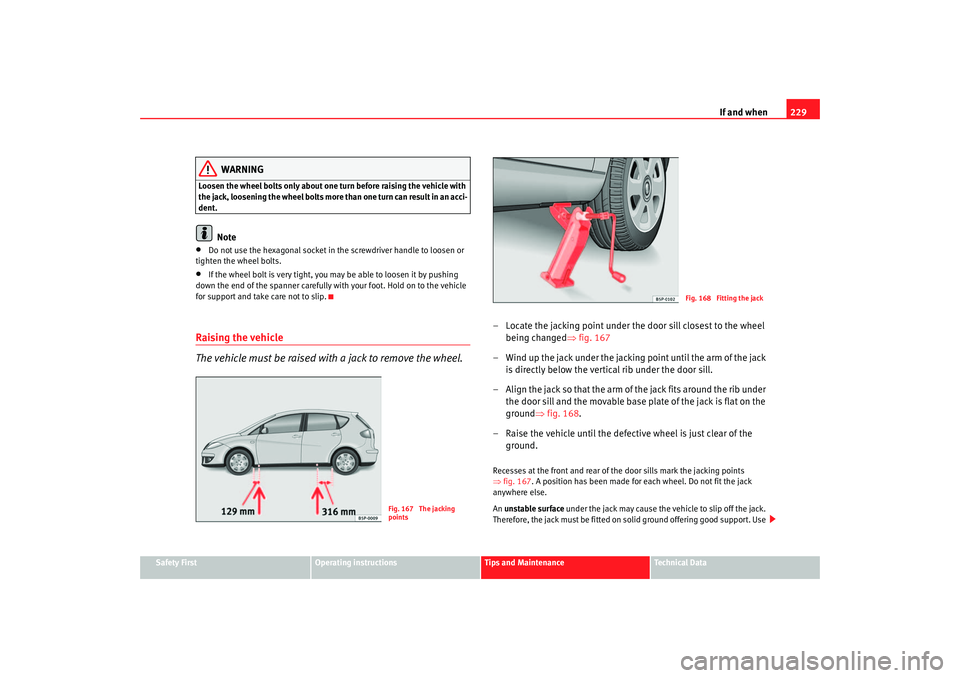
If and when229
Safety First
Operating instructions
Tips and Maintenance
Te c h n i c a l D a t a
WARNING
Loosen the wheel bolts only about one tu rn before raising the vehicle with
the jack, loosening the wheel bolts more than one turn can result in an acci-
dent.
Note
•
Do not use the hexagonal socket in th e screwdriver handle to loosen or
tighten the wheel bolts.
•
If the wheel bolt is very tight, you may be able to loosen it by pushing
down the end of the spanner carefully with your foot. Hold on to the vehicle
for support and take care not to slip.
Raising the vehicle
The vehicle must be raised with a jack to remove the wheel.
– Locate the jacking point under the door sill closest to the wheel being changed ⇒fig. 167
– Wind up the jack under the jacking point until the arm of the jack is directly below the vertical rib under the door sill.
– Align the jack so that the arm of the jack fits around the rib under the door sill and the movable base plate of the jack is flat on the
ground ⇒fig. 168 .
– Raise the vehicle until the defect ive wheel is just clear of the
ground.Recesses at the front and rear of the door sills mark the jacking points
⇒ fig. 167 . A position has been made for each wheel. Do not fit the jack
anywhere else.
An unstable surface under the jack may cause the vehicle to slip off the jack.
Therefore, the jack must be fitted on solid ground offering good support. Use
Fig. 167 The jacking
points
Fig. 168 Fitting the jack
altea_ingles Seite 229 Donnerstag, 19. Mai 2005 3:02 15
Page 232 of 286
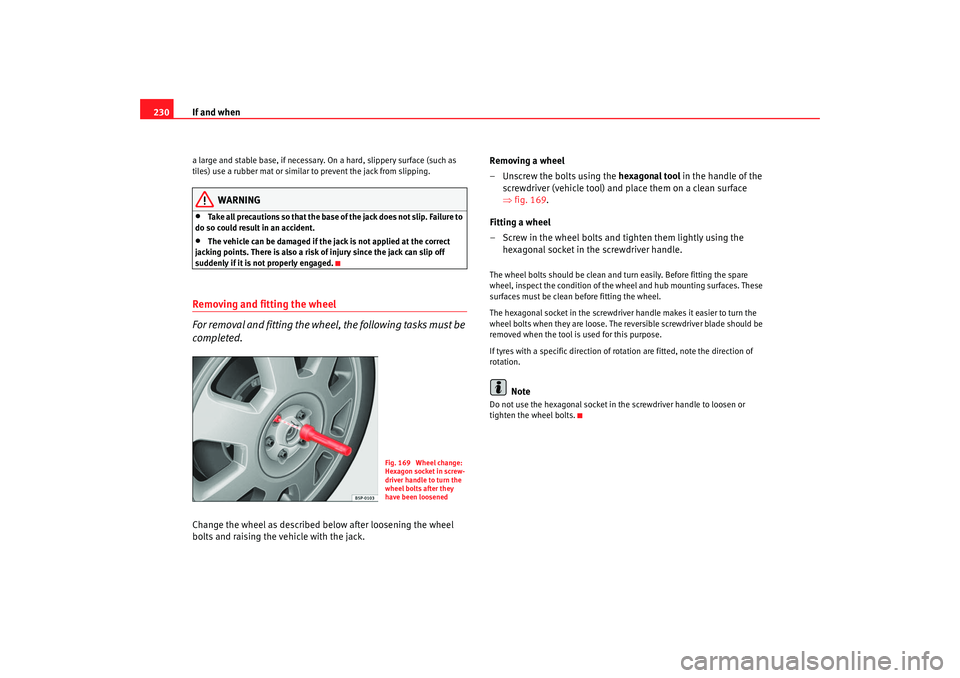
If and when
230a large and stable base, if necessary. On a hard, slippery surface (such as
tiles) use a rubber mat or similar to prevent the jack from slipping.
WARNING
•
Take all precautions so that the base of the jack does not slip. Failure to
do so could result in an accident.
•
The vehicle can be damaged if the jack is not applied at the correct
jacking points. There is also a risk of injury since the jack can slip off
suddenly if it is not properly engaged.
Removing and fitting the wheel
For removal and fitting the wheel, the following tasks must be
completed.Change the wheel as described below after loosening the wheel
bolts and raising the vehicle with the jack. Removing a wheel
– Unscrew the bolts using the
hexagonal tool in the handle of the
screwdriver (vehicle tool) and place them on a clean surface
⇒ fig. 169.
Fitting a wheel
– Screw in the wheel bolts and tighten them lightly using the hexagonal socket in the screwdriver handle.
The wheel bolts should be clean and turn easily. Before fitting the spare
wheel, inspect the condition of the whe el and hub mounting surfaces. These
surfaces must be clean before fitting the wheel.
The hexagonal socket in the screwdriver handle makes it easier to turn the
wheel bolts when they are loose. The reversible screwdrive r blade should be
removed when the tool is used for this purpose.
If tyres with a specific di rection of rotation are fitt ed, note the direction of
rotation.
Note
Do not use the hexagonal socket in the screwdriver handle to loosen or
tighten the wheel bolts.
Fig. 169 Wheel change:
Hexagon socket in screw-
driver handle to turn the
wheel bolts after they
have been loosened
altea_ingles Seite 230 Donnerstag, 19. Mai 2005 3:02 15
Page 255 of 286
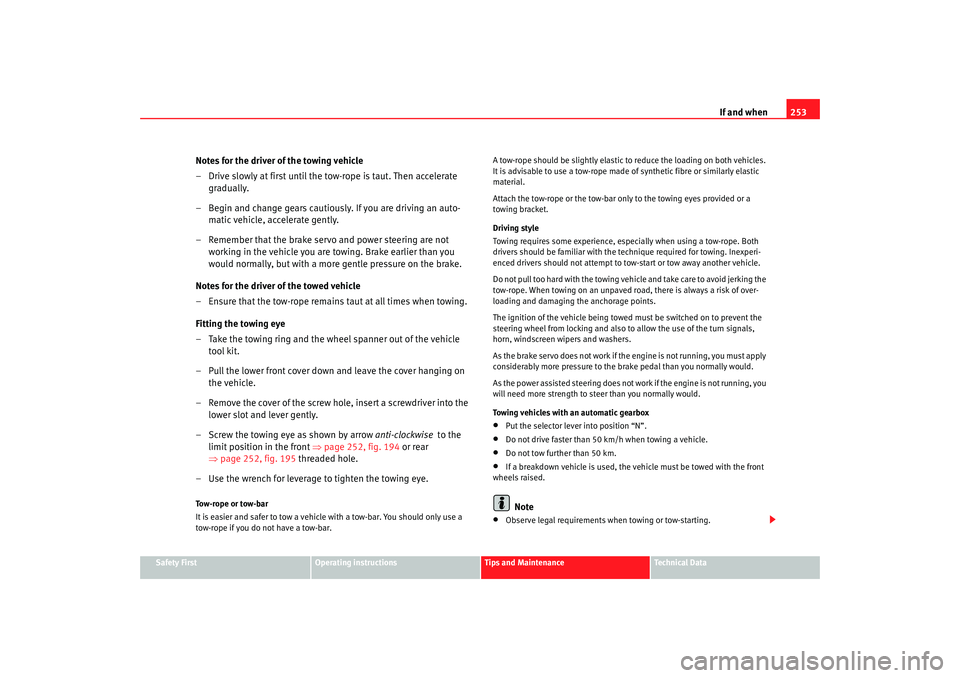
If and when253
Safety First
Operating instructions
Tips and Maintenance
Te c h n i c a l D a t a
Notes for the driver of the towing vehicle
– Drive slowly at first until the tow-rope is taut. Then accelerate
gradually.
– Begin and change gears cautiously. If you are driving an auto- matic vehicle, accelerate gently.
– Remember that the brake servo and power steering are not working in the vehicle you are towing. Brake earlier than you
would normally, but with a more gentle pressure on the brake.
Notes for the driver of the towed vehicle
– Ensure that the tow-rope remains taut at all times when towing.
Fitting the towing eye
– Take the towing ring and the wheel spanner out of the vehicle tool kit.
– Pull the lower front cover down and leave the cover hanging on the vehicle.
– Remove the cover of the screw hole, insert a screwdriver into the lower slot and lever gently.
– Screw the towing eye as shown by arrow anti-clockwise to the
limit position in the front ⇒page 252, fig. 194 or rear
⇒ page 252, fig. 195 threaded hole.
– Use the wrench for leverage to tighten the towing eye.Tow-rope or tow-bar
It is easier and safer to tow a vehicle with a tow-bar. You should only use a
tow-rope if you do not have a tow-bar. A tow-rope should be slightly elastic to
reduce the loading on both vehicles.
It is advisable to use a tow-rope made of synthetic fibre or similarly elastic
material.
Attach the tow-rope or the tow-bar only to the towing eyes provided or a
towing bracket.
Driving style
Towing requires some experience, especially when using a tow-rope. Both
drivers should be familiar with the technique required for towing. Inexperi-
enced drivers should not attempt to tow-start or tow away another vehicle.
Do not pull too hard with the towing vehicle and take care to avoid jerking the
tow-rope. When towing on an unpaved road, there is always a risk of over-
loading and damaging the anchorage points.
The ignition of the vehicle being towed must be switched on to prevent the
steering wheel from locking and also to allow the use of the turn signals,
horn, windscreen wipers and washers.
As the brake servo does not work if th e engine is not running, you must apply
considerably more pressure to the brake pedal than you normally would.
As the power assisted steering does not work if the engine is not running, you
will need more strength to steer than you normally would.
Towing vehicles with an automatic gearbox
•
Put the selector lever into position “N”.
•
Do not drive faster than 50 km/h when towing a vehicle.
•
Do not tow further than 50 km.
•
If a breakdown vehicle is used, the vehicle must be towed with the front
wheels raised.Note
•
Observe legal requirements when towing or tow-starting.
altea_ingles Seite 253 Donnerstag, 19. Mai 2005 3:02 15
Page 260 of 286
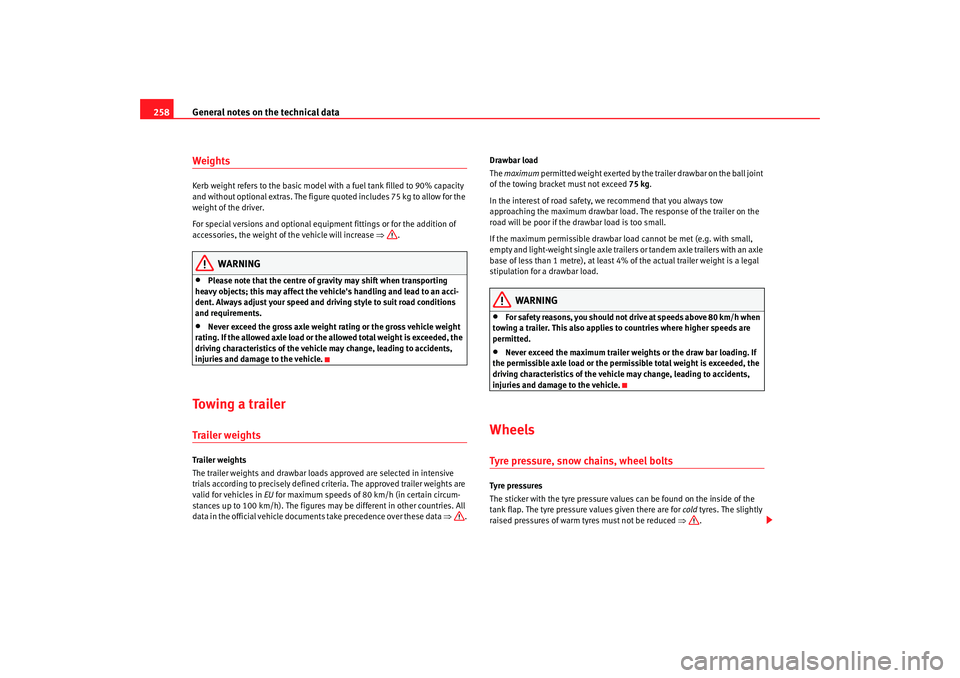
General notes on the technical data
258WeightsKerb weight refers to the basic model with a fuel tank filled to 90% capacity
and without optional extras. The figure quoted includes 75 kg to allow for the
weight of the driver.
For special versions and optional equipment fittings or for the addition of
accessories, the weight of the vehicle will increase ⇒.
WARNING
•
Please note that the centre of gravity may shift when transporting
heavy objects; this may affect the vehi cle's handling and lead to an acci-
dent. Always adjust your speed and dr iving style to suit road conditions
and requirements.
•
Never exceed the gross axle weight rating or the gross vehicle weight
rating. If the allowed axle load or the allowed total weight is exceeded, the
driving characteristics of the vehicle may change, leading to accidents,
injuries and damage to the vehicle.
To w i n g a t r a i l e rTrailer weightsTrailer weights
The trailer weights and drawbar loads approved are selected in intensive
trials according to precisely defined criteria. The approved trailer weights are
valid for vehicles in EU for maximum speeds of 80 km/h (in certain circum-
stances up to 100 km/h). The figures may be different in other countries. All
data in the official vehicle documents take precedence over these data ⇒. Drawbar load
The
maximum permitted weight exerted by the trailer drawbar on the ball joint
of the towing bracket must not exceed 75 kg.
In the interest of road safety, we recommend that you always tow
approaching the maximum drawbar load. The response of the trailer on the
road will be poor if th e drawbar load is too small.
If the maximum permissible drawbar load cannot be met (e.g. w ith small,
empty and light-weight single axle trailers or tandem axle trailers with an axle
base of less than 1 metre), at least 4% of the actual trailer weight is a legal
stipulation for a drawbar load.
WARNING
•
For safety reasons, you should not drive at speeds above 80 km/h when
towing a trailer. This also applies to countries where higher speeds are
permitted.
•
Never exceed the maximum trailer weights or the draw bar loading. If
the permissible axle load or the perm issible total weight is exceeded, the
driving characteristics of the vehicle may change, leading to accidents,
injuries and damage to the vehicle.
WheelsTyre pressure, snow chains, wheel boltsTyre pressures
The sticker with the tyre pressure values can be found on the inside of the
tank flap. The tyre pressure values given there are for cold tyres. The slightly
raised pressures of warm tyres must not be reduced ⇒.
altea_ingles Seite 258 Donnerstag, 19. Mai 2005 3:02 15
Page 261 of 286

General notes on the technical data 259
Safety First
Operating instructions
Tips and Maintenance
Te c h n i c a l D a t a
Snow chains
Snow chains may be fitted only to the
front wheels.
Consult the chapter “wheels” of this manual.
Wheel bolts
After the wheels have been changed, the tightening torque of the wheel bolts
should be checked as soon as possible with a torque wrench ⇒. The tight-
ening torque for steel and alloy wheels is 120 Nm.
WARNING
•
Check the tyre pressure at least once per month. Correct tyre pressure
is very important. If the tyre pressure is too high or too low, there is an
increased danger of accidents, particularly at high speeds.
•
If the torque of the wheel bolts is too low, they could loosen whilst the
vehicle is in motion. Risk of accident! If the tightening torque is too high,
the wheel bolts and threads could be damaged.Note
We recommend that you ask your Authorised Service Centre for information
about appropriate wheel, tyre and snow chain size.
altea_ingles Seite 259 Donnerstag, 19. Mai 2005 3:02 15
Page 275 of 286
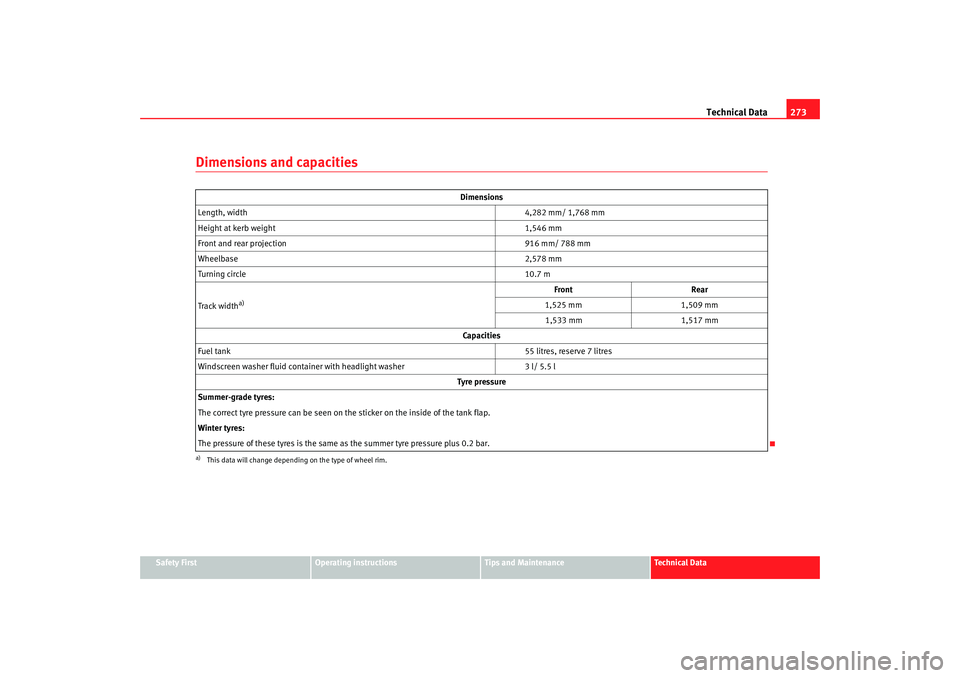
Technical Data273
Safety First
Operating instructions
Tips and Maintenance
Te c h n i c a l D a t a
Dimensions and capacities
Dimensions
Length, width 4,282 mm/ 1,768 mm
Height at kerb weight 1,546 mm
Front and rear projection 916 mm/ 788 mm
Wheelbase 2,578 mm
Turning circle 10.7 m
Track width
a)
a)This data will change depending on the type of wheel rim.
Front Rear
1,525 mm 1,509
mm
1,533 mm 1,517 mm
Capacities
Fuel tank 55 litres, reserve 7 litres
Windscreen washer fluid container with headlight washer 3 l/ 5.5 l
Tyre pressure
Summer-grade tyres:
The correct tyre pressure can be seen on the sticker on the inside of the tank flap.
Winter tyres:
The pressure of these tyres is the same as the summer tyre pressure plus 0.2 bar.
altea_ingles Seite 273 Donnerstag, 19. Mai 2005 3:02 15
Page 278 of 286
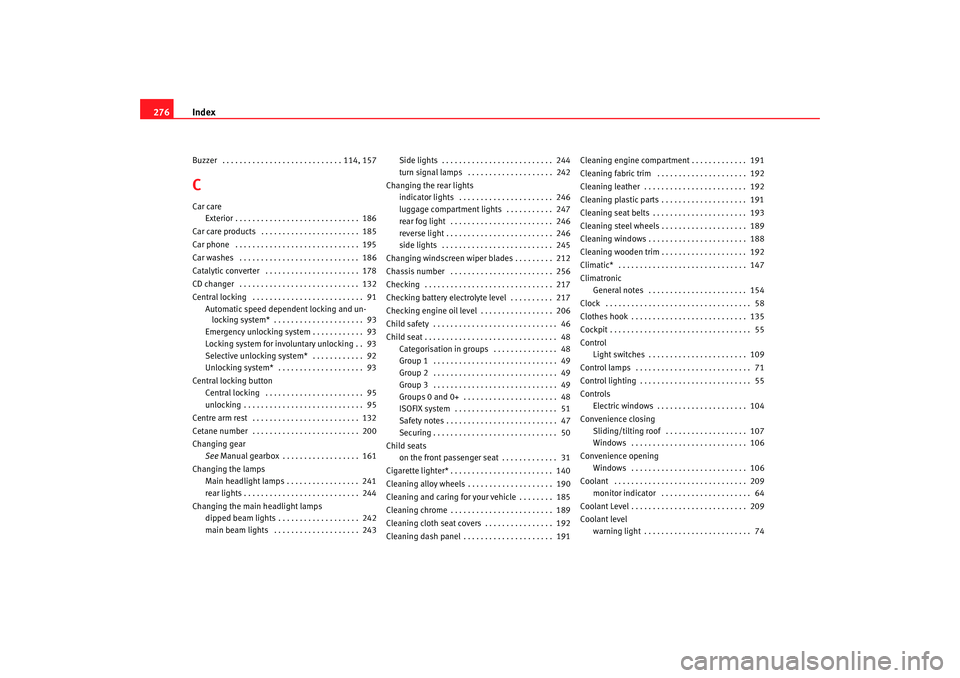
Index
276Buzzer . . . . . . . . . . . . . . . . . . . . . . . . . . . . 114, 157CCar care
Exterior . . . . . . . . . . . . . . . . . . . . . . . . . . . . . 186
Car care products . . . . . . . . . . . . . . . . . . . . . . . 185
Car phone . . . . . . . . . . . . . . . . . . . . . . . . . . . . . 195
Car washes . . . . . . . . . . . . . . . . . . . . . . . . . . . . 186
Catalytic converter . . . . . . . . . . . . . . . . . . . . . . 178
CD changer . . . . . . . . . . . . . . . . . . . . . . . . . . . . 132
Central locking . . . . . . . . . . . . . . . . . . . . . . . . . . 91 Automatic speed dependent locking and un-locking system* . . . . . . . . . . . . . . . . . . . . . 93
Emergency unlocking system . . . . . . . . . . . . 93
Locking system for invo luntary unlocking . . 93
Selective unlocking system* . . . . . . . . . . . . 92
Unlocking system* . . . . . . . . . . . . . . . . . . . . 93
Central locking button Central locking . . . . . . . . . . . . . . . . . . . . . . . 95
unlocking . . . . . . . . . . . . . . . . . . . . . . . . . . . . 95
Centre arm rest . . . . . . . . . . . . . . . . . . . . . . . . . 132
Cetane number . . . . . . . . . . . . . . . . . . . . . . . . . 200
Changing gear See Manual gearbox . . . . . . . . . . . . . . . . . . 161
Changing the lamps Main headlight lamps . . . . . . . . . . . . . . . . . 241
rear lights . . . . . . . . . . . . . . . . . . . . . . . . . . . 244
Changing the main headlight lamps
dipped beam lights . . . . . . . . . . . . . . . . . . . 242
main beam lights . . . . . . . . . . . . . . . . . . . . 243 Side lights . . . . . . . . . . . . . . . . . . . . . . . . . . 244
turn signal lamps . . . . . . . . . . . . . . . . . . . . 242
Changing the rear lights indicator lights . . . . . . . . . . . . . . . . . . . . . . 246
luggage compartment lights . . . . . . . . . . . 247
rear fog light . . . . . . . . . . . . . . . . . . . . . . . . 246
reverse light . . . . . . . . . . . . . . . . . . . . . . . . . 246
side lights . . . . . . . . . . . . . . . . . . . . . . . . . . 245
Changing windscreen wiper blades . . . . . . . . . 212
Chassis number . . . . . . . . . . . . . . . . . . . . . . . . 256
Checking . . . . . . . . . . . . . . . . . . . . . . . . . . . . . . 217
Checking battery electrolyte level . . . . . . . . . . 217
Checking engine oil level . . . . . . . . . . . . . . . . . 206
Child safety . . . . . . . . . . . . . . . . . . . . . . . . . . . . . 46
Child seat . . . . . . . . . . . . . . . . . . . . . . . . . . . . . . . 48 Categorisation in groups . . . . . . . . . . . . . . . 48
Group 1 . . . . . . . . . . . . . . . . . . . . . . . . . . . . . 49
Group 2 . . . . . . . . . . . . . . . . . . . . . . . . . . . . . 49
Group 3 . . . . . . . . . . . . . . . . . . . . . . . . . . . . . 49
Groups 0 and 0+ . . . . . . . . . . . . . . . . . . . . . . 48
ISOFIX system . . . . . . . . . . . . . . . . . . . . . . . . 51
Safety notes . . . . . . . . . . . . . . . . . . . . . . . . . . 47
Securing . . . . . . . . . . . . . . . . . . . . . . . . . . . . . 50
Child seats on the front passenger seat . . . . . . . . . . . . . 31
Cigarette lighter* . . . . . . . . . . . . . . . . . . . . . . . . 140
Cleaning alloy wheels . . . . . . . . . . . . . . . . . . . . 190
Cleaning and caring for your vehicle . . . . . . . . 185
Cleaning chrome . . . . . . . . . . . . . . . . . . . . . . . . 189
Cleaning cloth seat covers . . . . . . . . . . . . . . . . 192
Cleaning dash panel . . . . . . . . . . . . . . . . . . . . . 191 Cleaning engine compartment . . . . . . . . . . . . . 191
Cleaning fabric trim . . . . . . . . . . . . . . . . . . . . . 192
Cleaning leather . . . . . . . . . . . . . . . . . . . . . . . . 192
Cleaning plastic parts . . . . . . . . . . . . . . . . . . . . 191
Cleaning seat belts . . . . . . . . . . . . . . . . . . . . . . 193
Cleaning steel wheels . . . . . . . . . . . . . . . . . . . . 189
Cleaning windows . . . . . . . . . . . . . . . . . . . . . . . 188
Cleaning wooden trim . . . . . . . . . . . . . . . . . . . . 192
Climatic* . . . . . . . . . . . . . . . . . . . . . . . . . . . . . . 147
Climatronic
General notes . . . . . . . . . . . . . . . . . . . . . . . 154
Clock . . . . . . . . . . . . . . . . . . . . . . . . . . . . . . . . . . 58
Clothes hook . . . . . . . . . . . . . . . . . . . . . . . . . . . 135
Cockpit . . . . . . . . . . . . . . . . . . . . . . . . . . . . . . . . . 55
Control Light switches . . . . . . . . . . . . . . . . . . . . . . . 109
Control lamps . . . . . . . . . . . . . . . . . . . . . . . . . . . 71
Control lighting . . . . . . . . . . . . . . . . . . . . . . . . . . 55
Controls Electric windows . . . . . . . . . . . . . . . . . . . . . 104
Convenience closing Sliding/tilting roof . . . . . . . . . . . . . . . . . . . 107
Windows . . . . . . . . . . . . . . . . . . . . . . . . . . . 106
Convenience opening Windows . . . . . . . . . . . . . . . . . . . . . . . . . . . 106
Coolant . . . . . . . . . . . . . . . . . . . . . . . . . . . . . . . 209 monitor indicator . . . . . . . . . . . . . . . . . . . . . 64
Coolant Level . . . . . . . . . . . . . . . . . . . . . . . . . . . 209
Coolant level warning light . . . . . . . . . . . . . . . . . . . . . . . . . 74
altea_ingles Seite 276 Donnerstag, 19. Mai 2005 3:02 15
Page 284 of 286
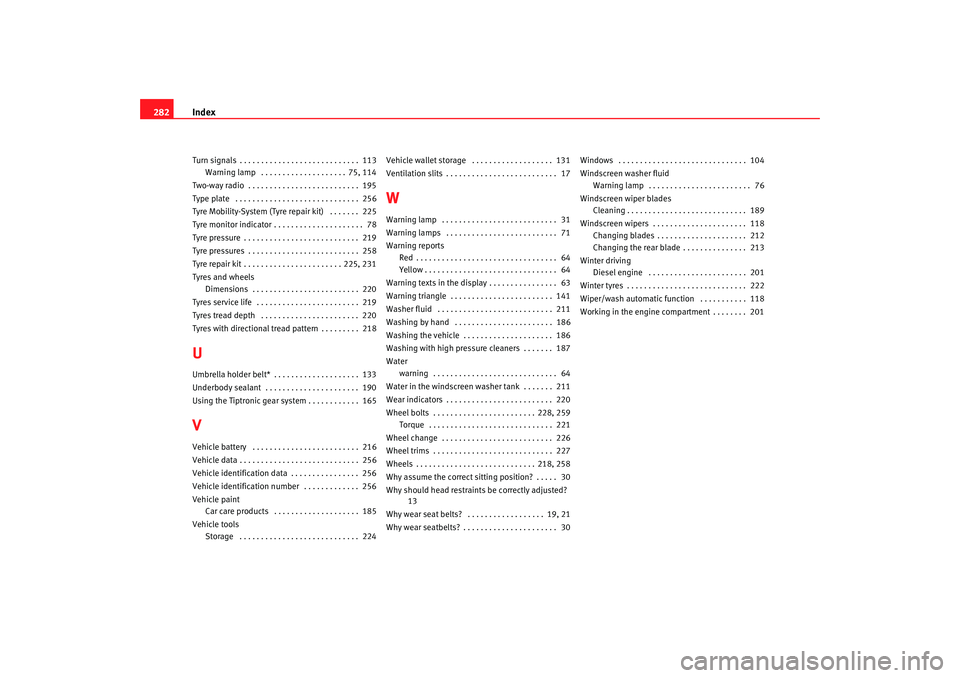
Index
282Turn signals . . . . . . . . . . . . . . . . . . . . . . . . . . . . 113
Warning lamp . . . . . . . . . . . . . . . . . . . . 75, 114
Two-way radio . . . . . . . . . . . . . . . . . . . . . . . . . . 195
Type plate . . . . . . . . . . . . . . . . . . . . . . . . . . . . . 256
Tyre Mobility-System (Tyre repair kit) . . . . . . . 225
Tyre monitor indicator . . . . . . . . . . . . . . . . . . . . . 78
Tyre pressure . . . . . . . . . . . . . . . . . . . . . . . . . . . 219
Tyre pressures . . . . . . . . . . . . . . . . . . . . . . . . . . 258
Tyre repair kit . . . . . . . . . . . . . . . . . . . . . . . 225, 231
Tyres and wheels Dimensions . . . . . . . . . . . . . . . . . . . . . . . . . 220
Tyres service life . . . . . . . . . . . . . . . . . . . . . . . . 219
Tyres tread depth . . . . . . . . . . . . . . . . . . . . . . . 220
Tyres with directional tread pattern . . . . . . . . . 218UUmbrella holder belt* . . . . . . . . . . . . . . . . . . . . 133
Underbody sealant . . . . . . . . . . . . . . . . . . . . . . 190
Using the Tiptronic gear system . . . . . . . . . . . . 165VVehicle battery . . . . . . . . . . . . . . . . . . . . . . . . . 216
Vehicle data . . . . . . . . . . . . . . . . . . . . . . . . . . . . 256
Vehicle identification data . . . . . . . . . . . . . . . . 256
Vehicle identification number . . . . . . . . . . . . . 256
Vehicle paint Car care products . . . . . . . . . . . . . . . . . . . . 185
Vehicle tools Storage . . . . . . . . . . . . . . . . . . . . . . . . . . . . 224 Vehicle wallet storage . . . . . . . . . . . . . . . . . . . 131
Ventilation slits . . . . . . . . . . . . . . . . . . . . . . . . . . 17
WWarning lamp . . . . . . . . . . . . . . . . . . . . . . . . . . . 31
Warning lamps . . . . . . . . . . . . . . . . . . . . . . . . . . 71
Warning reports
Red . . . . . . . . . . . . . . . . . . . . . . . . . . . . . . . . . 64
Yellow . . . . . . . . . . . . . . . . . . . . . . . . . . . . . . . 64
Warning texts in the display . . . . . . . . . . . . . . . . 63
Warning triangle . . . . . . . . . . . . . . . . . . . . . . . . 141
Washer fluid . . . . . . . . . . . . . . . . . . . . . . . . . . . 211
Washing by hand . . . . . . . . . . . . . . . . . . . . . . . 186
Washing the vehicle . . . . . . . . . . . . . . . . . . . . . 186
Washing with high pressure cleaners . . . . . . . 187
Water warning . . . . . . . . . . . . . . . . . . . . . . . . . . . . . 64
Water in the windscreen washer tank . . . . . . . 211
Wear indicators . . . . . . . . . . . . . . . . . . . . . . . . . 220
Wheel bolts . . . . . . . . . . . . . . . . . . . . . . . . 228, 259 Torque . . . . . . . . . . . . . . . . . . . . . . . . . . . . . 221
Wheel change . . . . . . . . . . . . . . . . . . . . . . . . . . 226
Wheel trims . . . . . . . . . . . . . . . . . . . . . . . . . . . . 227
Wheels . . . . . . . . . . . . . . . . . . . . . . . . . . . . 218, 258
Why assume the correct sitting position? . . . . . 30
Why should head restraints be correctly adjusted? 13
Why wear seat belts? . . . . . . . . . . . . . . . . . . 19, 21
Why wear seatbelts? . . . . . . . . . . . . . . . . . . . . . . 30 Windows . . . . . . . . . . . . . . . . . . . . . . . . . . . . . . 104
Windscreen washer fluid
Warning lamp . . . . . . . . . . . . . . . . . . . . . . . . 76
Windscreen wiper blades Cleaning . . . . . . . . . . . . . . . . . . . . . . . . . . . . 189
Windscreen wipers . . . . . . . . . . . . . . . . . . . . . . 118 Changing blades . . . . . . . . . . . . . . . . . . . . . 212
Changing the rear blade . . . . . . . . . . . . . . . 213
Winter driving Diesel engine . . . . . . . . . . . . . . . . . . . . . . . 201
Winter tyres . . . . . . . . . . . . . . . . . . . . . . . . . . . . 222
Wiper/wash automatic function . . . . . . . . . . . 118
Working in the engine compartment . . . . . . . . 201
altea_ingles Seite 282 Donnerstag, 19. Mai 2005 3:02 15